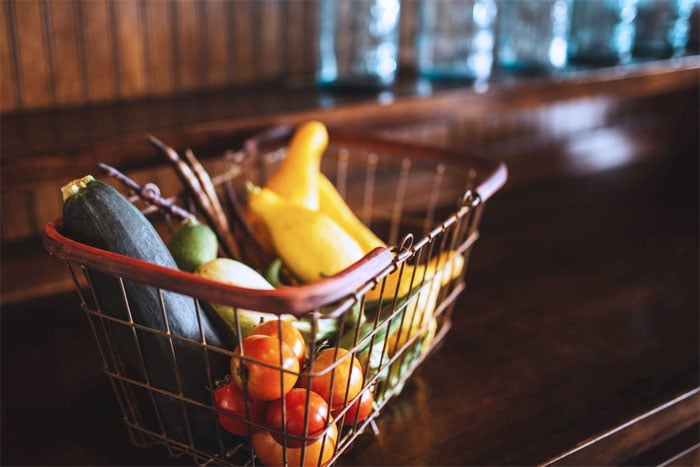
Written By: Beth Ehrensberger, RD
Title: Registered Dietitian
Alumni: University of Tennessee, Knoxville
Last Updated on:

Is your grocery bill sometimes enough to raise your blood pressure? Some people think that filling the grocery cart with healthy food will blow the budget at the cash register.
But you don’t have to sacrifice good nutrition for a reasonable grocery bill. One key to keeping the receipt within reason is to truly commit to a basket of healthy foods. If you’re filling your basket with healthy foods AND adding in boxes of trans-fat filled cookies, salt-laden chips and other packaged “extras,” you will end up with a hefty bill. But get rid of the junk and you’ll have plenty of grocery money to invest in high quality, healthy food and still stay within your budget. With a little practice, healthy grocery shopping on a budget will become second nature!

Table of Contents
¼ is enough: You don’t have to unload a good portion of your budget on meats. The USDA’s Dietary Guidelines suggest a diet that is built around whole grains, vegetables, fruits and low-fat dairy, accented by lean meats.
Think of your mealtime plate as a pie chart – about ½ of your plate should be filled with vegetables and fruits, ¼ filled with a whole grain, and about ¼ of your plate should be a protein source like lean meat, so you don’t need to buy as much as you might think.
For added savings, buy larger portions than you need, divide into individual servings when you get home, and then freeze for later; you will save by purchasing in bulk.
Try alternatives: Don’t forget that protein isn’t just found in meat – try trading lean meats for other protein sources a couple times a week. Beans, tofu, nuts, and eggs all make excellent protein choices that are good for your health and your wallet, too.
Go seasonal: The produce aisle is another common area to suffer grocery store sticker shock. Seasonal fruits and vegetables taste best and are often much less expensive than imported out-of-season varieties, so choose those when possible. Structure meals around produce in season, and you will see a significant savings.
Convenience is not inferior: When fresh produce is simply too budget prohibitive, try the frozen version, or canned with no added salt. Research suggests that canned or frozen fruits and vegetables are just as good, and in some cases, even better, than fresh. If you’re concerned about sodium, try rinsing canned vegetables before cooking.
Plan ahead: Another way to cut costs in the produce department is to design a weekly menu, and match your grocery shopping to the meals on the menu. A well-planned menu brimming with healthy meals will reduce the likelihood for waste, especially on produce and other fresh foods. A bunch of fresh asparagus on sale isn’t a deal if it spoils before you can eat it.
It doesn’t have to cost a fortune to do your healthy grocery shopping on a budget. Commit to buying healthy foods in place of packaged junk. Plan your grocery trip, shop from a list, make a few adjustments to your purchasing, and your bill will leave you pleasantly surprised!
Alumni: University of Tennessee, Knoxville – Beth Sumrell Ehrensberger is a Registered Dietitian and holds a Master Degree in Public Health. An experienced nutrition counselor, writer and public speaker, Beth specializes in translating complex nutrition information into practical concepts. Beth was awarded a Nutrition Communications Fellowship to the National Cancer Institute, and has worked on the internationally recognized Nutrition Action Healthletter of the Center for Science in the Public Interest.